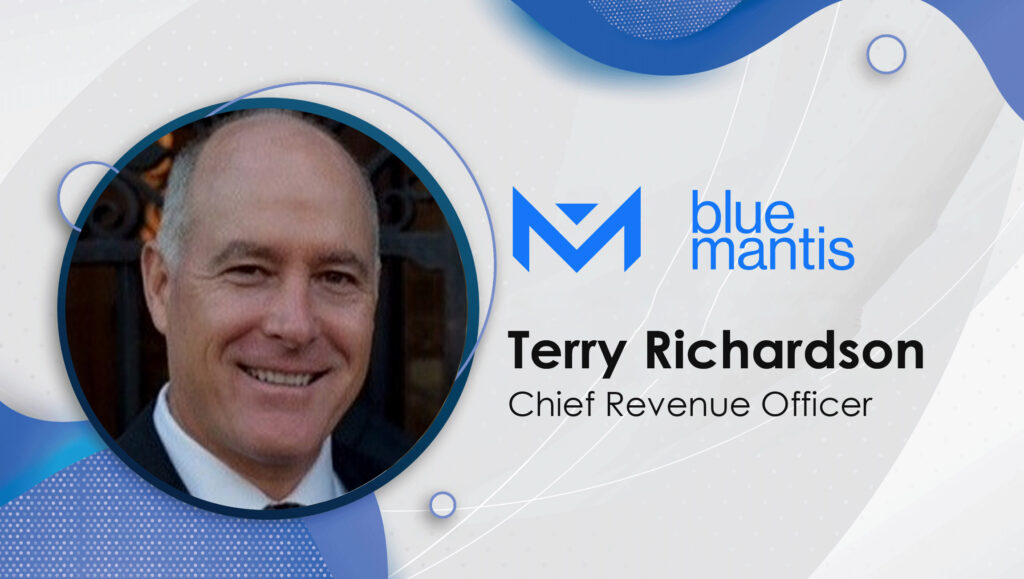Terry Richardson CRO at Blue Mantis (formerly known as GreenPages) comments on the latest trends impacting how modern day B2B CROs function in this catch-up with SalesTechStar:
__________
Welcome to this SalesTechStar chat Terry, tell us about yourself and your role at Blue Mantis…
I joined GreenPages (now Blue Mantis) as Chief Revenue Officer in May 2023. In this role, I lead all of the company’s revenue-generating activities, including partner relationship management and business development. My focus is to drive continued rapid growth by working with our sales and technical teams in accelerating our success in our three “pillar” areas – cloud, cybersecurity and managed services.
I have dedicated my 30+ year career to enterprise technology and have experience in global channel, enterprise and OEM sales. Most recently I was the North American Channel Chief at AMD. Prior to AMD, I spent more than a decade at HP and HPE in sales leadership roles, more than five years at SEPATON as EVP of Worldwide Sales and five years at EMC Corp. in various enterprise, channel, and OEM sales roles. I also worked at Data General for nearly a decade prior to its acquisition by EMC.
Take us through some of your go-to market strategies and how they have enabled business goals: a few proven best practices for B2B teams.
I am focused on internal ecosystem alignment around the core revenue and growth revenue objectives, working with business development, pre-sales and sales teams to help everyone understand their role in helping us achieve our goals. We have seven practice areas and we have a clearly defined and differentiated go-to-market plan for increasing both revenue and customer satisfaction for each of those segments.
Among my GMT strategies consistently employed include: first, focusing heavily on partners and identifying, nurturing and collaborating with the strongest and most committed partners who will help us achieve our business goals. Critical to this is identifying both current strategic partners and emerging partners. Second, to remain nimble and effective, I have prioritized the training of sales leaders to modify their governance practices with their sales teams to ensure they are optimized and focused on the practice and partnership areas. Third, is to avoid the trap of focusing on “making the sales number.” That is short-sighted. Instead, I strive to create disciplines on how we achieve the sales goal and ensure customer satisfaction. These two objectives go hand-in-hand. Key to this effort is the creation and utilization of a measurement system that allows a sales team to make progress and to make necessary course corrections if actions are not delivering desired outcomes and results.
Read More: SalesTechStar Interview with Micael Oliveira, Founder & CRO at Amplemarket
How can tech brands today work on achieving more revenue growth through different channels in your view?
To reach new customers, I believe that B2B tech brands should always be engaging their available partner ecosystems and shift more of their focus onto those partners who have demonstrated broad technical expertise and a strong ability to create and leverage thought marketing.
The cloud has enabled many new non-traditional models to reach new customers and should be fully and consistently leveraged. To that end, B2B tech brands should embrace digital providers and service-centric partners, as well as traditional infrastructure companies. We are in the business of ensuring positive customer outcomes and therefore, I encourage tech brands to evaluate partners from the lens of their software and services expertise. Independent software vendors (ISVs) and core professional services firms are other strong partner options that continue to be increasingly critical to leverage to meet revenue growth goals.
How do you feel the goals of the typical B2B CRO should change in 2023?
Without question, today’s B2B CRO must look more closely at profitability. They have to strive for profitable growth by continuously managing and monitoring the recurring revenue line. I cannot understate the importance of this objective. Beyond MRR, services measurement goals are critical. I would also recommend a strong emphasis on new customer acquisition and adoption so the customer base becomes more diverse from a vertical, geographical and market size perspective.
The B2B CRO must also be an expert in selling and broadening relationships with existing customers too. The role of his or her customer success team becomes even more critical in environments like the one we are in today. Finally, they must be very proficient in leveraging marketing and other digital marketing techniques to increase the number of new customers.
Read More: How Headless LMS can Solve the Retail Training Gap
A few top of mind tips and sales tech best practices you’d share with B2B sales teams for 2023?
A few things are critical. First is the importance of relationships and relationship development. At the end of the day we are in a ‘people business’ – we do business with those we know, like and trust. We now live and work in an era of remote and hybrid work environments and while this brings great flexibility, it cannot come at the expense of in-person relationship development.
Sales professionals should always leverage their networks when looking to identify new contacts in any given account and forge relationships with those individuals. I also recommend tracking the amount of time and energy required to developing new contacts at customers and partners.
One of my favorite sayings I use with my sales team is ‘make it personal.’ Get to a point where you have deep personal relationships with customers, not just as an acquaintance on someone you interact with on a transactional level. Another personal best practice is planning. Whether it is account planning or business planning with a partner, it has become a bit of a lost art. But it really should not be ignored. Most successful sales people are great at planning. Another best practice is to focus on expanding the ‘share of wallet’ in an account. This is a terrific measurement and a sign of a healthy relationship.
Some takeaways on how you feel the B2B sales and revenue stream will evolve in the next few years?
I expect that customer buying behavior will shift toward a consumption model vs. a straight capital purchase. We are seeing many vendor partnerships formed including HPE GreenLake, Dell APEX and Lenovo-TruScale – to offer these types of alternatives. This gives customers flexibility in hardware and infrastructure purchases akin to SaaS and cloud consumption models that can scale up or down based on actual resource utilization, not a fixed pricing model.
Additionally, security will become pervasive in customer buying decisions – hardware, software and services. We must make security a core element of almost every touch point in the sales journey. How secure is the product? The supply chain that develops and delivers it? In services, protections must be in place to ensure that security standards are adhered to. Also steps to ensure code cannot be breached are of paramount importance.
Finally, given the growing and necessary focus on climate change, decisions around solutions that demonstrate sustainability and green initiatives will increase in favor so customers can achieve their ESG goals.
Blue Mantis (fka GreenPages) offers digital technology services and strategic guidance on emerging technologies.
Terry Richardson is CRO at Blue Mantis.






















